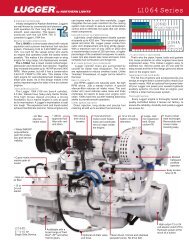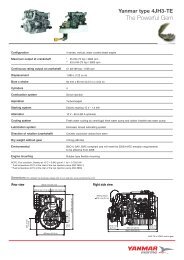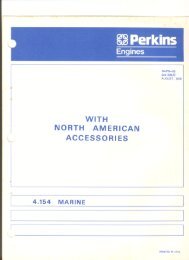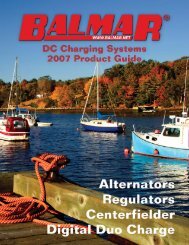The good-old Peterson 44 – After 45,000 miles
The good-old Peterson 44 – After 45,000 miles
The good-old Peterson 44 – After 45,000 miles
You also want an ePaper? Increase the reach of your titles
YUMPU automatically turns print PDFs into web optimized ePapers that Google loves.
<strong>The</strong> P-<strong>44</strong>’s main saloon is, unfortunately, dominated by the presence of the mast running right through the<br />
dinette table. But it’s a “feature” you get used to that provides a <strong>good</strong> handh<strong>old</strong> in rough weather and a <strong>good</strong><br />
place to fix a kerosene lamp. Across the way, the starboard settee makes a great seaberth.<br />
Tankage for water is under the cabin<br />
sole in four s.s. tanks totaling 125 gallons.<br />
<strong>The</strong>se tanks have been known to<br />
leak, so be sure to inspect them. <strong>The</strong> fuel<br />
tanks were originally steel and also have<br />
caused problems; on Zorana, we just had<br />
the great fun of replacing them with nice<br />
new aluminum ones.<br />
Back in the ‘70s and early ‘80s, several<br />
P-<strong>44</strong>s were put into the charter trade down<br />
in St. Lucia, West Indies, and Raiatea,<br />
French Polynesia. <strong>The</strong>y became quite famous<br />
for their bullet-proof qualities.<br />
<strong>The</strong>se P-<strong>44</strong>s were ridden hard and put<br />
away wet, so buyer beware. A few P-<strong>44</strong>s<br />
were imported to Europe in the early<br />
1980s, and Zorana was one of these.<br />
<strong>The</strong> shakedown<br />
In the spring of 1985, we drove to<br />
Flensburg to commission our new/<strong>old</strong><br />
boat. Our plan was to enjoy Zorana for<br />
the Scandinavian summer, see what she<br />
needed, and sail to England to outfit her.<br />
She was really bare-bones, with only the<br />
original three sails, one <strong>45</strong>-lb. fake CQR<br />
and minimum electronics. We put on a<br />
VHF, hard dinghy with motor, and a secondhand<br />
spinnaker. By the time we got<br />
to England, we had proven she could sail<br />
with the big boys, as the summer had<br />
proven to be mean and nasty. As we<br />
moored in Emsworth on England’s south<br />
coast, our list included installing an Ar-<br />
ies windvane, Sat-Nav (remember<br />
those?), stove crash-bar, binnacle crashbar<br />
and getting a 90% jib and a storm<br />
staysail made.<br />
Completing our first outfit, we<br />
skedaddled out of England as it was time<br />
to get south. Our trip down the Bay of<br />
Biscay, northwest Spain, Portugal and<br />
Madeira was uneventful as far as Zorana<br />
was concerned. However, we weathered<br />
several gales and continued to drag our<br />
fake CQR anchor in several countries anchorages.<br />
We should have bought a real<br />
CQR in England, but you can’t remember<br />
everything!<br />
<strong>After</strong> enjoying the warmth in the Canaries,<br />
we provisioned and set off for our<br />
first long passage <strong>–</strong> transatlantic to the<br />
Caribbean. <strong>After</strong> headwinds for a week<br />
and then less than normal trade winds,<br />
we were still able to average over 135<br />
<strong>miles</strong> a day in lazy comfort with a poledout<br />
genoa or occasional spinnaker.<br />
Congratulating ourselves on a safe<br />
passage while anchored in Marigot Bay,<br />
I was restoring some gear under the aft<br />
bunk when I noticed that the steering<br />
cable had frayed at the turning block and<br />
was literally hanging by a thread. This<br />
would have been a real mess at sea if it<br />
had broken. <strong>After</strong> removing the block and<br />
filing off the offending eighth-inch of<br />
stainless, we have not had a recurring<br />
problem.<br />
Refit for the Pacific<br />
Number-two outfitting took place in<br />
the Virgin Islands as we readied Zorana<br />
for the South Pacific. Now we’re getting<br />
serious about anchoring. We had a better<br />
and stronger bow-roller made, and put<br />
the <strong>old</strong> one on the port side. We purchased<br />
a real 60-lb. CQR to go with our<br />
200-feet of 3/8” chain for our main system.<br />
For storms, we got a 66-lb. Bruce<br />
with chain and rode, plus a 40-lb. real<br />
CQR for back-up. <strong>The</strong>n we had a fulllength<br />
cockpit bimini made, and with<br />
closed-cell cockpit cushions, we have<br />
our comforts. Noticing a flex problem at<br />
the forestay deck chainplate, we had<br />
made a backing-plate with padeye and<br />
installed a babystay down to the hull.<br />
Next, we had to change our propane system<br />
for the European trade-in bottles to<br />
two American 20-lb. aluminum bottles,<br />
which entailed enlarging our propane/<br />
helm box, but now we had enough gas<br />
for three to five months.<br />
Departing the Virgin Islands, Zorana<br />
zoomed downwind to the Panama Canal<br />
and then to the San Blas Islands, which<br />
we had cruised in a previous boat back<br />
in 1973 and (nice to say) things hadn’t<br />
changed that much. <strong>The</strong> Panama Canal,<br />
unfortunately, is not changing for the<br />
better; however, our passage was uneventful<br />
and reasonable.<br />
4 Blue Water Sailing






